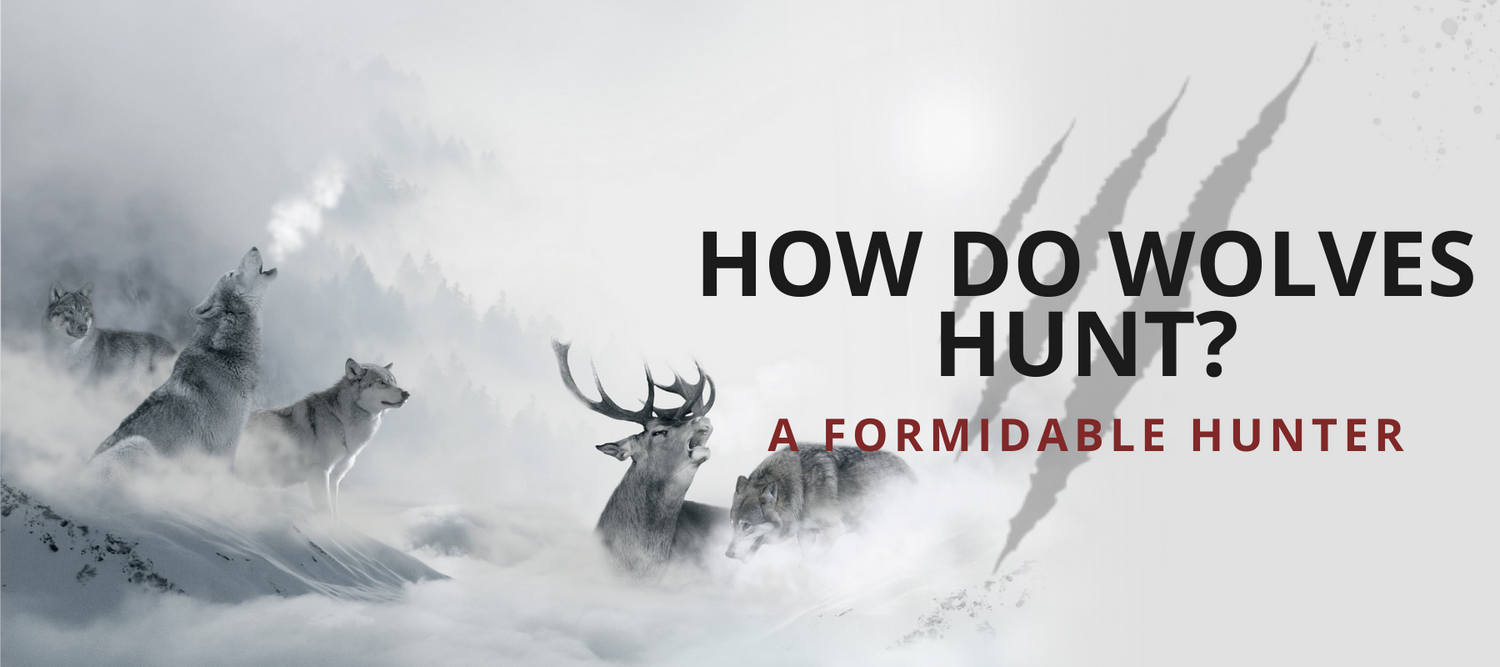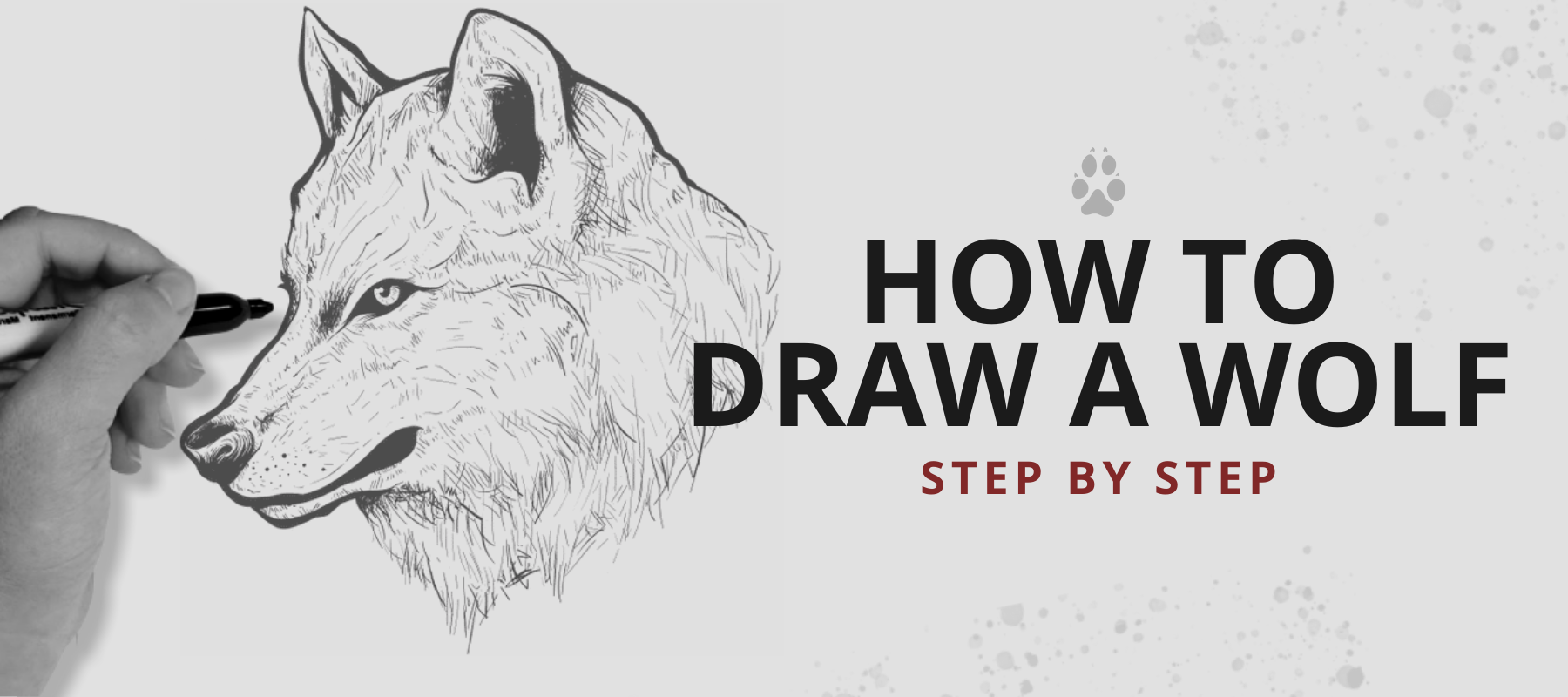The wolf is a carnivorous animal, it feeds mainly on meat. Living beyond the reach of humans, in the wild, the wolf hunts for food. The wolf possesses skills that allow him to hunt. In this article we will discover how do wolves hunt and what are their abilities to be one of the most incredible hunters in the animal kingdom.

HUNTING ABILITIES OF THE WOLF
-
Powerful Fangs
The wolf (Canis Lupus), a carnivore by nature, has natural abilities that allow it to hunt its prey. The adult gray wolf has 42 teeth and four fangs. Its fangs measure an average of 6 cm, 2 cm of which are in the gums. They allow him to tear his meal to pieces and, when hunting, to perforate the skin of his prey and cling to it.
Its powerful jaw exerts an average force of 150 kg/cm while that of the dog is 60 kg/cm which allows it to hunt all types of prey in animal kingdom.
-
A developed sens of smell
One of its assets is its powerful sense of smell, which enables it to detect prey two kilometers away. He can also use the scent left behind by an animal to stalk it.
-
A good memory
He knows his territory and habitat by heart. When hunting, he is able to remember shortcuts to catch up with the animal being taken. His good memory and developed sense of smell give him the ability, from the urine, to recognize the animal and its sex.
He is able to remember if he has ever smelled the urine in question and thus identify the animal or if it comes from an unknown animal. He also recognizes the places where he has already hunted.
-
An amazing speed
Its speed allows it to catch its prey. It runs at an average speed of 40 km/h and can reach a maximum speed of 60 km/h which it can withstand in a short sprint. The wolf has a high stamina compared to other canids.
WHAT DOES THE WOLF HUNT?
This carnivorous animal should, by nature, only feed on fresh meat. But it also feeds on other sources of wildlife. The wolf hunts large animals such as:
- Deer: Animals that belong to the ruminant mammal family. They live in temperate zones precisely in the forests of Africa, North America, North Asia and Europe.
- Bison: Ruminant cattle that live in Europe and North America.
- Sheep: Mammals that eat grass. They are among the first animals domesticated by man and are found all over the world.
- Caribou: They mainly live in Canada.
But, they also feed on small prey such as :
- Rabbits and rodents. They can be found all over the world.
- Foxes: they are part of the group of canids along with wolves. They can be found in North Africa, Canada, Asia, Europe, and the Middle East.
- Hares: they look like rabbits but are bigger. They are found in America, especially in the United States.
If needed, wolves also feed on fruits (blueberries, berries), frogs, insects, fish or carcasses.
In order to be efficient and to limit fatigue during the hunt, the wild wolf has developed several tactics of hunting.

WOLF HUNTING TACTICS
In order to success in their hunt, these majestic beats establish attack strategies. Here are wolf hunting tactics:
First, the wolf has to spot its prey. He uses three techniques:
- The first technique is that he only advances until he locates a prey.
- The second technique is that he starts following a scent that he has spotted either by the wind or by urine, etc. In the first two techniques, the wolf moves against the direction of the wind to avoid being spotted by its scent.
- His third technique consists of following the footprints left by the animal. Here, the wolf no longer pays attention to the wind.
Wolves tend to get as close as possible to their prey before attacking them by surprise. When the surprise attack is launched, the wolves begin to pursue the prey.
If they can't reach the prey after about 400 meters, they give up the hunt. If they are close enough to the victim during the run, they start biting the animal to make it impossible to escape. They bite it on the legs or flanks. Then the leader of the pack tries to restrain the animal by holding its muzzle between its teeth while the others throw themselves at it to finish it off.
Wolves pay particular attention to sick animals, old or young, because they are easy prey. When the pack spots a herd of deer, for example, they launch an offensive with the aim of separating the herd and succeeding in isolating an animal that they will take on the hunt. If they notice that the herd has remained united, then they give up after a while.
It happens that some animals, instead of fleeing from the wolf's assault, turn around and attack them. In such situations, the wolves give up and flee. Oxen will tend to glue their massive bodies, lower their horns and run in unison on the wolves to give them horn blows.
Wolves frequently approach the livestock of herders, so they usually wait until night to approach the livestock because wolves are naturally afraid of humans.
If you also want to become one with your inner wolf hunter, discover this amazing hoodie hunting partner.

DOES WOLF HUNT ALONE?
The wolf has the ability to hunt alone but it's a social animal that lives in community and prefers to hunt in packs. It's more efficient and less tiring while allowing them to hunt bigger prey.

HOW FOOD IS SHARED AFTER A SUCCESSFUL HUNT?
After the wolf hunt has been successful, it's time to have a meal. This is done in a specific order. As mentioned above, the wolf is a social animal and usually lives in a pack. The dominant male and female are the first to eat, then the rest of the pack will pounce on the rest of the food to help themselves. In the case of large prey such as deer, the wolf pack may decide to stay on the spot for days and eat the meat down to the last bite.

HOW IS CUB INTRODUCED TO HUNTING?
From birth, the Cub has a predation instinct that he develops through play. During the game with his brothers and sisters, the offspring learns to camouflage himself and leaps at them unexpectedly, a skill that is necessary during the hunt and which allows him to direct the prey towards other wolves.
Wolf pups also learns how to fight, develop combat tactics and other skills. Sometimes the mother hunts small animals that she gives to their cubs, so they can practice using their fangs.
TO SUM UP...
In conclusion, the wolf is an incredible hunter adaptable to its hostile environment. Its memory, sense of smell, sight, speed, fangs and the strength of its jaw are powerful assets to hunt. The wolf has the ability to follow a prey and kill it alone but prefers to do so in a pack by ambushing the prey.
After the hunt, the dominant couple always eat first. As for young wolves, they are introduced to hunting at an early age, notably through play and by forging their canines in the game brought back by their mother.
Now that you know how do wolves hunt, do no hesitate to discover what does it mean when a wolf howl.




